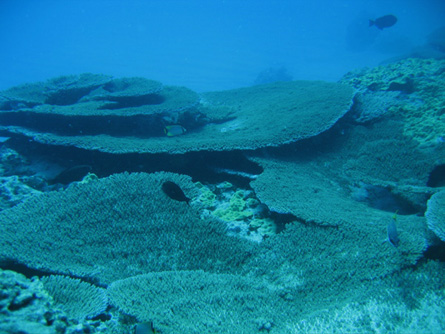|
You
are here: /main/research
expeditions/May 2006/Days
14-16 Johnston Atoll
Days
14-16, Table corals abound at Johnston Atoll, but something
is making them sick
Evening
of June 4, 2006
by
Dr. Malia Rivera

A healthy Acropora
cytherea reef typical of French Frigate Shoals.
The reefs at Johnston Atoll look pretty different from what we’ve been seeing in the Northwestern Islands.
Absent from most of the Hawaiian archipelago, the table coral Acropora
cytherea dominates here. The only
other place table corals are found in Hawai‘i is at French Frigate Shoals, yet another piece of evidence
suggesting that the two atolls are connected biologically.
But, there is another big difference here compared to the reefs of the NWHI. The table
corals seem to be severely diseased with what the coral biologists are calling “white syndrome,”
which infects the colonies’ surface and slowly spreads, eventually killing the reef in most cases.
The levels of white syndrome being observed here astonish Dr. Michael Stat, a post-doctoral researcher.
When I asked him what he was finding at Johnston, he replied with somewhat of a tone of resignation
“there is a LOT more disease here.”

Close up of "white syndrome" disease, which infects many reefs at Johnston Atoll. Photo by Greta Aeby
Michael is part of a team of coral biologists onboard working on questions related to what
factors might make a coral either more resistant, or more susceptible to diseases and/or
bleaching. As a central focus of this work in Dr. Ruth Gates laboratory at HIMB, Michael
is attempting to tease apart the role of the algal symbiont from the genus Symbiodinium that lives within the tissues of many species of corals. Symbiodinium is a type of
zooxanthellae, which like most plants, is photosynthetic. The single celled algas line
the digestive tracts of the coral polyps and provide an energy source for the colonies,
producing carbohydrates and oxygen on which the coral reefs depend to live and grow.
The Gates lab is extracting the DNA material from the Symbiodinium to examine what genetic types
of zooxanthellae are in the corals in Hawai‘i and Johnston. There are several “types” of these
symbiotic algae known throughout the world. So far, of the handful of Acropora colonies that Michael
sampled last year from the Hawaiian archipelago, he has found that tissues from healthy coral from
French Frigate Shoals contained all one type of Symbiodinium, while all the ones with white syndrome
had a completely different type. Here at Johnston, so much of the Acropora are infected that Michael
is getting many new samples in which he can compare to healthy reefs from the Northwestern Hawaiian
Islands, and to the some of the healthy reefs that still remain at Johnston Atoll.
In addition to sampling coral tissues, Michael, with help from the Gates Laboratory technician Jay Wheeler,
is sampling the water just above the reefs. They are doing this in order to see what types of Symbiodinium are available for uptake by the reefs beneath to try and figure out if corals are being selective in what
kind of zooxanthellae they retain in their digestive tracts. “We are also sampling many more species of
corals, so we can get a much better idea just of what kinds of Symbiodinium is out there,” says Michael.
The results thus far have far-reaching implications for managers. Unfortunately, white syndrome
has already reached French Frigate Shoals, albeit at a much lower prevalence. If the pattern of
algae symbionts holds true, researchers will be able to provide important information on just
what may contribute to a coral’s ability to resist diseases, and which reefs may need special
attention should a disease outbreak occur.
|